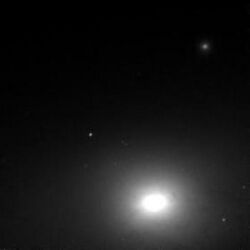Astronomy:NGC 4546
| NGC 4546 | |
|---|---|
 NGC 4546 - Hubble Space Telescope - Hubble Legacy Archive | |
| Observation data (J2000.0 epoch) | |
| Constellation | Virgo |
| Right ascension | 12h 35m 29.5s[1] |
| Declination | −03° 47′ 35.5″[1] |
| Redshift | 0.003492 |
| Helio radial velocity | 1057 ± 5 km/s[1] |
| Distance | 45.6 Mly |
| Apparent magnitude (V) | 10.57[1] |
| Characteristics | |
| Type | SB0−[1] |
| Other designations | |
| PGC 41939, MCG-1-32-27, UGC 288 | |
NGC 4546 is a lenticular field galaxy located in the direction of the constellation Virgo,[2] with a total population of globular clusters estimated at about 390.[3] It is a member of the Virgo II Groups, a series of galaxies and galaxy clusters strung out from the southern edge of the Virgo Supercluster.[4]
Located 45.6 million light years away, with a stellar mass of about 27 billion solar masses,[1] it has a declination of -03° 47' 35" and an average rise of 12 hours, 35 minutes and 29.5 seconds.[5] NGC 4546 was discovered on December 29, 1786 by William Herschel.[6][1][3]
The galaxy appears to be home to a supermassive black hole with a mass of 256 million (± 16 million) times the mass of the Sun.[7] It is estimated to have 390±60 globular clusters.[8]
NGC 4546 appears to have at least 2 companions,[8] NGC 4546-UCD1 and CGCG 014-074.[8]
References
- ↑ 1.0 1.1 1.2 1.3 1.4 1.5 1.6 Escudero, C. G.; Faifer, F. R.; Castelli, A. V. Smith; Norris, M. A.; Forte, J. C. (2020-02-07). "Field/Isolated lenticular galaxies with high $S_N$ values: the case of NGC 4546 and its globular cluster system". Monthly Notices of the Royal Astronomical Society 493 (2): 2253–2270. doi:10.1093/mnras/staa392. Bibcode: 2020MNRAS.493.2253E.
- ↑ Rojas, Sebastián García. "Galaxy NGC 4546 - Galaxy in Virgo Constellation" (in en). https://telescopius.com/deep-sky/object/5599/ngc-4546/galaxy.
- ↑ 3.0 3.1 "Astronomers studied lenticular galaxy NGC 4546 in detail" (in en-US). Tech Explorist. 2020-02-18. https://www.techexplorist.com/astronomers-studied-lenticular-galaxy-ngc-4546-detail/30142/.
- ↑ "The Virgo III Groups". Atlas of the Universe. http://www.atlasoftheuniverse.com/galgrps/viriii.html.
- ↑ Ford, Dominic. "The galaxy NGC 4546 - In-The-Sky.org" (in en). https://in-the-sky.org/data/object.php?id=NGC4546.
- ↑ "NGC 4546 - Galaxy - SKY-MAP". http://server7.sky-map.org/starview?object_type=2&object_id=826&object_name=NGC+4546&locale=EN.
- ↑ Ricci, T V; Steiner, J E (21 May 2020). "Measuring the mass of the supermassive black hole of the lenticular galaxy NGC 4546". Monthly Notices of the Royal Astronomical Society 495 (3): 2620–2629. doi:10.1093/mnras/staa1398. https://academic.oup.com/mnras/article-abstract/495/3/2620/5841527?redirectedFrom=fulltext. Retrieved 29 June 2020.
- ↑ 8.0 8.1 8.2 Escudero, Carlos G; Faifer, Favio R; Castelli, Analía V Smith; Norris, Mark A; Forte, Juan C (April 2020). "Field/isolated lenticular galaxies with high SN values: the case of NGC 4546 and its globular cluster system". Monthly Notices of the Royal Astronomical Society 493 (2): 2253–2270. doi:10.1093/mnras/staa392. Bibcode: 2020MNRAS.493.2253E. https://academic.oup.com/mnras/article-abstract/493/2/2253/5731864?redirectedFrom=fulltext. Retrieved 29 June 2020.
External links
- NGC 4546 on WikiSky: DSS2, SDSS, GALEX, IRAS, Hydrogen α, X-Ray, Astrophoto, Sky Map, Articles and images
 |

